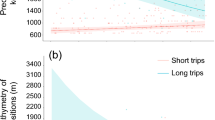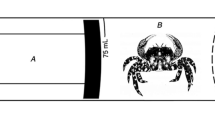Abstract
Plasma sodium concentrations in field-caught Western tiger snakes, Notechis scutatus, from semi-arid Carnac Island (CI) varied seasonally, with snakes exhibiting significant hypernatraemia during summer and normal concentrations following autumn rain. In contrast, field-caught tiger snakes from a perennial fresh-water swamp (Herdsman Lake, HL) exhibited no significant increase in plasma sodium concentrations during summer. Laboratory-induced hypernatraemia caused thermal depression in both populations; there was a weak negative relationship between plasma sodium concentration and temperature selection that was significant for CI snakes. Hypernatraemia significantly elevated circulating concentrations of the neuropeptide arginine vasotocin (AVT) in both CI and HL snakes. CI snakes injected with a physiological dosage of AVT also evidenced thermal depression. Despite the positive correlation between AVT and both plasma sodium concentration and osmolality for laboratory snakes, field samples from CI snakes indicate that circulating levels of AVT may be influenced more by plasma osmolality than sodium levels. The data suggest that, in CI snakes, chronic dehydration in the field leads to hypernatraemia which may lead to elevated levels of AVT if plasma osmolality also increases. This will in turn invoke a depression in thermal behaviour that may improve the water economy and survival of snakes on semi-arid CI. Although HL snakes do not experience seasonal dehydration, physiological changes away from the stable homeostatic state appear to prompt the same behavioural shifts, illustrating the intrinsic nature of the thermal behaviour in different populations of the same species of snake.








Similar content being viewed by others
Abbreviations
- AVT:
-
Arginine vasotocin
- CI:
-
Carnac Island
- HLH:
-
Herdsman Lake
- [Na+]:
-
Plasma sodium concentration
- BM:
-
Body mass
- SVL:
-
Snout-vent length
- BCI:
-
Body condition index
- SL:
-
Salt loading régime
- WL:
-
Water loading régime
- PBT:
-
Preferred body temperature
- AMT:
-
Average maximum temperature
- MTS:
-
Median temperature selected
- AVP:
-
Arginine vasopressin
References
Atchley WR, Gaskins CT, Anderson D (1976) Statistical properties of ratios I. Empirical results. Syst Zool 25:137–148
Baverstock PR, Bradshaw SD (1975) Variation in rate of growth and adrenal corticosteroidogenesis in field and laboratory populations of the lizard Amphibolurus ornatus. Comp Biochem Physiol 52A:557–566
Bentley PJ (1976) Osmoregulation. In: Gans C, Dawson WR (eds) Biology of the Reptilia. Academic, New York, pp 365–412
Beuchat CA (1986) Reproductive influences on the thermoregulatory behavior of a live-bearing lizard. Copeia 1986:971–979
Bonnet X, Pearson D, Ladyman MT, Lourdais O, Bradshaw SD (2002) ‘Heaven” for serpents? A mark-recapture study of tiger snakes (Notechis scutatus) on Carnac Island, Western Australia. Aust Ecol 27:442–450
Bradshaw SD, Bradshaw FJ (2002) Arginine vasotocin: site and mode of action in the reptilian kidney. Gen Comp Endocrinol 126:7–13
Bradshaw SD, Rice GE (1981) The effects of pituitary and adrenal hormones on renal and post-renal reabsorption of water and electrolytes in the lizard Varanus gouldii (Gray). Gen Comp Endocrinol 44:82–93
Bradshaw SD (1970) Seasonal changes in the water and electrolyte metabolism of Amphibolurus lizards in the field. Comp Biochem Physiol 36:689–718
Bradshaw SD (1986) Ecophysiology of desert reptiles. Academic, Sydney, pp 323
Bradshaw SD (1997) Homeostasis in desert reptiles. Springer, Berlin Heidelberg New York, pp 213
Bradshaw SD, Shoemaker VH (1967) Aspects of water and electrolyte changes in a field population of Amphibolurus lizards. Comp Biochem Physiol 20:855–865
Charland MB, Gregory PT (1990) The influence of female reproductive status on thermoregulation in a viviparous snake, Crotalus virdis. Copeia 4:1089–1098
Crowley SR (1987) The effect of desiccation on the preferred body temperature and activity level of the lizard Sceloporus undulates. Copeia 1:25–32
Dantzler WH (1989) Comparative physiology of the vertebrate kidney. Springer, Berlin Heidelberg New York
De Witt CB, Friedman RM (1979) Significance of skewness in ectotherm regulation. Am Zool 19:195–209
Dessauer HC (1970) Blood chemistry of reptiles: physiological and evolutionary aspects. In: Gans C, Parsons TS (eds) Biology of the Reptilia. Academic, New York, pp 1–72
Dme’il R, Zilber B (1971) Water balance in a desert snake. Copeia 1971:754–755
Dupré RK, Crawford EC Jr (1985) Behavioral thermoregulation during dehydration and osmotic loading of the desert iguana. Physiol Zool 58:357–363
Dupré RK, Crawford EC (1986) Elevation of the panting threshold of the desert iguana, Dipsosaurus dorsalis, during dehydration: potential roles of changes in osmolality and body fluid volume. J Comp Physiol 156B:377–381
Fergusson B, Bradshaw SD (1990) Plasma arginine vasotocin, progesterone and luteal development during pregnancy in the viviparous lizard, Tiliqua rugosa. Gen Comp Endocrinol 82:140–151
Figler RA, MacKenzie DS, Owens DW, Licht P, Amoss MS (1989) Increased levels of arginine vasotocin and neurophysin during nesting in sea turtles. Gen Comp Endocrinol 73:223–232
Garrick LD (1974) Reproductive influences on behavioral thermoregulation in the lizard Sceloporus cyanogenys. Physiol Behav 12:85–91
Goldstein DL, Braun EJ (1988) Contributions of the kidneys and intestines to water conservation and plasma levels of antidiuretic hormone during dehydration in the house sparrows Passer domesticus. J Comp Physiol B 158:353–362
Goldstein DL (2002) Water and salt balance in seabirds. In: Schreiber EA, Burgur J (eds) Biology of marine birds. CRC, Boca Raton, pp 467–480
Greer AE (1990) The biology and evolution of Australian lizards. Surrey Beatty & Sons, Sydney
Gregory PT, Crampton LH, Skebo KM (1999) Conflicts and interactions among reproduction, thermoregulation and feeding in viviparous reptiles: are gravid snakes anorexic? J Zool 248:231–241
Grenot C (1976) Ecophysiologie du lézard saharien Uromastix acanthinurus (Bell, 1825) (Agamidae, herbivore). Pub Lab Zool ENS Paris 7:1–323
Hertz PE, Huey RB, Stevenson RD (1993) Evaluating temperature regulation by field-active ectotherms: the fallacy of the inappropriate question. Am Nat 142:796–818
Koike TI, Pryor LR, Neldon HL (1979) Effect of saline infusion on plasma immunoreactive vasotocin in conscious chickens (Gallus domesticus). Gen Comp Endocrinol 37:451–458
La Rochelle FT, North WG, Stern P (1980) A new extraction of arginine vasopressin from blood: the use of octadecasilyl-silica. Pfluegers Arch 387:79–81
Ladyman MT, Bradshaw SD (2003) The influence of dehydration on the thermal preferences of the Western tiger snake, Notechis scutatus. J Comp Physiol B 173:239–246
Lecomte J, Clobert J, Massot M (1993) Shift in behaviour related to pregnancy in Lacerta vivipara. Revue d’Ecologie (Terre Vie) 48:99–107
Lutterschmidt D, Hutchinson VH (2003) Influence of thyroid hormones on the thermal selection of African house snakes (Lamprophis fuliginosus). J Therm Biol 28:167–173
Madsen T, Shine R (2002) Short and chubby or long and slim? Food intake, growth and body condition in free-ranging pythons. Aust Ecol 27:672–680
Mancera JM, Fernandez-Llebrez P, Perez-Figares JM (1990) Estudio immunocitoquimico del lobulo neural hipofisario de Natrix maura en deshidratacion. Rev Esp Fisiol 46:183–190
Minnich JE (1979) Reptiles. In: Maloiy GMO (ed) Comparative physiology of osmoregulation in animals. Academic, New York, pp 391–641
Minnich JE (1982) The use of water. In: Gans C, Pough FH (eds) Biology of the Reptilia. Academic, New York, pp 325–395
Morgan RC, Lazarow A (1963) Immunoassay of insulin: two antibody system. Diabetes 12:115–126
Nagy KA (1973) Behaviour, diet and reproduction in a desert lizard, Sauromalus obesus. Copeia 1973:93–102
Pang PKT, Uchiyama M, Sawyer WH (1982) Endocrine and neural control of amphibian renal functions. Fed Proc 41:2365–2370
Parent A (1979) Monoaminergic systems of the brain. In: Gans C, Northcutt RG, Ulinski P (eds) Biology of the Reptilia. Academic, New York, pp 247–285
Rice GE (1982) Plasma arginine vasotocin concentrations in the lizard Varanus gouldii (Gray) following water loading, salt loading and dehydration. Gen Comp Endocrinol 47:1–6
Richmond CA (2003) The role of arginine vasopressin in thermoregulation during fever. J Neurosci Nurs 35:281–286
Rosenbloom AA, Fisher DA (1974) Radioimmunoassay of arginine vasotocin. Endocrinology 95:1726–1732
Saint Girons H, Bradshaw SD (1981) Preliminary observation on behavioural thermoregulation in an elapid snake, the dugite, Pseudonaja affinis (Gunther). J Roy Soc West Aust 4:13–16
Saint Girons H, Bradshaw SD, Bradshaw FJ (1993) Sexual activity and plasma levels of sex steroids in the Aspic viper, Vipera aspis L. (Reptilia, Viperidae). Gen Comp Endocrinol 91:287–297
Scott IAW, Hayes JS, Keogh JS, Webb JK (2001) Isolation and characterization of novel microsatellite markers from the Australian Tiger snakes (Elapidae: Notechis) and amplification in the closely related genus Hoplocephalus. Mol. Ecol Notes 1:117–120
Shine R, Lambeck R (1990) Seasonal shifts in thermoregulatory behaviour of Australian Blacksnakes, Pseudechis porphyriacus (Elapidae). J Herp 24:302–308
Shoemaker VH, Nagy KA (1977) Osmoregulation in amphibians and reptiles. Ann Rev Physiol 39:449–471
Silveira PF, Schiripa LN, Carmona E, Picarelli ZP (1992) Circulating vasotocin in the snake Bothrops jararaca. Comp Biochem Physiol 103A:59–64
Silveira PF, Koike TI, Schiripa LN, Reichl AP, Magnoli FC (1998) Plasma arginine-vasotocin and hydroosmotic status of the terrestrial pit viper Bothrops jararaca. Gen Comp Endocrinol 109:336–346
Smits AW (1984) Ecological and physiological correlates of water balance and body fluid compartmentation in the chuckwalla lizard, Sauromalus hispidus. Unpublished PhD dissertation, University of Kansas Lawrence, Kansas
Smits AW, Ward J, Lillywhite H (1986) Effects of hyperkalemia on thermoregulatory behaviors of the lizard, Sauromalus hispidus. Copeia 1986:520–523
Stallone JN, Braun EJ (1986a) Osmotic and volume regulation of plasma arginine vasotocin in conscious domestic fowl. Am J Physiol 250:R644–R657
Stallone JN, Braun EJ (1986b) Regulation of plasma arginine vasotocin in conscious water-deprived domestic fowl. Am J Physiol 250:R658–R664
Statsoft (1995) Statistica 5.1: general conventions and statistics. Statsoft, Tulsa
Statsoft (2001) Statistica 6.0: general conventions and statistics. Statsoft, Tulsa
Zar JH (1999) Biostatistical analysis. Prentice-Hall, New Jersey, 929 pp
Acknowledgements
The School of Animal Biology and Centre for Native Animal Research, The University of Western Australia, provided funding for the research and UWA Ethics Committee approved all experimental procedures (AEC# 01/100/165). The Department of Conservation and Land Management (DCLM) issued licenses for the collection of animals (SF003795 & NE002981). Thanks to Jamie O’Shea and Stewart Ford for valuable comments on the MS and to Fabien Aubret for accompaniment in the field and to Xavier Bonnet for access to field data.
Author information
Authors and Affiliations
Corresponding author
Additional information
Communicated by I.D. Hume
Rights and permissions
About this article
Cite this article
Ladyman, M., Bradshaw, D. & Bradshaw, F. Physiological and hormonal control of thermal depression in the tiger snake, Notechis scutatus . J Comp Physiol B 176, 547–557 (2006). https://doi.org/10.1007/s00360-006-0077-8
Received:
Revised:
Accepted:
Published:
Issue Date:
DOI: https://doi.org/10.1007/s00360-006-0077-8




